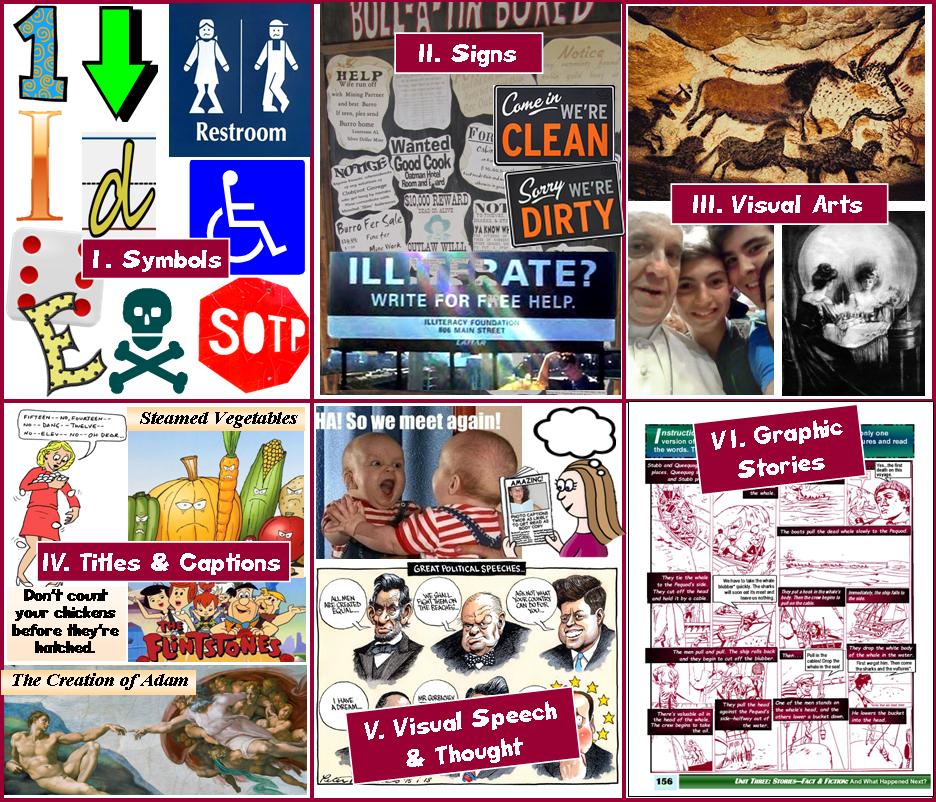Usually, “literacy” means competency in reading & writing print matter. "Visual literacy" means the ability to look at and understand types of flat (2-D) images other than text. These might be photos, paintings, drawings, illustrations, icons, or any number of other formats.
-
Which of these kinds of visual reading do you seek out?
-
Which do you avoid?
-
Which interest or attract you?
-
Which affect you negatively?
Do you have any commentary about the six kinds of “Visual Reading” displayed above? As an intro to teaching “Visual Literacy,” here are a few defining explanations:
-
Symbols can include numbers, alphabetic letters, and icons understood around the world, and the simplest of drawings or shapes.
-
Signs may contain symbols (figures, logos, designs) and/or illustrations—or they can be composed of words. Their physical attributes (size, shape, material, location) are likely to give clues to their meaning.
-
Visual or Graphic Arts can be photographs, paintings, drawings (line, shaded, cartoons), and illustrations composed of mixed media.
-
Titles or Captions can accompany any of the images mentioned above. Though secondary to the visuals, these give clues to their importance, meanings, or messages.
-
Visual Speech or Thought can be added to any kind of visual works of art. Most often, it clarifies the message of the artist—and/or of the people or characters shown in the picture.
-
Graphic Stories combine illustrations and other artwork with text to convey meaning—both narration of the action and the speech or thought of the characters.
So what do we need to know (and teach others) about “reading for meaning” with material that’s all visual, a combination of images and words, or words that give only physical cues to their meaning? From What’s the Point? Book One: Beginning to Read for Meaning and other sources, here are summaries of the pedagogy related to six kinds of “Visual Literacy.” For full explanations from the text—with exercise excerpts to practice following the directives—click on the underlined Part Titles below.
-
To Get the Point of Symbols: For numbers (Arabic, Roman, etc.), determine “how many.” Connect the shapes of alphabetic letters to the sounds they make when combined in words. Notice the typical features of icons or simple drawings to figure out what they represent.
Here’s more explanation and a few exercises from the beginning of Part 1: The Point of Symbols & Signs from What’s the Point? Book One: Beginning to Read for Meaning.
Want more practice in the meanings and uses of symbols? There’s a 104-card deck of illustrated playing cards, with 26 suits of four images each, for instruction, practice, and assessment—and a lot of game-play fun. It’s accompanied by a 36-page book called Symbols Card Decks A-Z: Creative Activity & Game Ideas for Teaching & Learning Symbols in 26 Meaning Categories.
-
To Get the Point of Signs: Determine the purpose of a sign by its location (its “context”) and its shape, color, and design (e.g. does it communicate danger, a warning, a prohibition, or what?) If there are only symbols, icons, or illustrations on the sign, name the images. Tell yourself what the notice wants you to do or not do in regard to the visuals. Read and understand the most prominent (noticeable) words. Check if they correspond to the illustration, if any. Put them into the real-life context. If the message is commercial or public service, paraphrase what its intents or purposes are. Decide for yourself if you want to ignore what it says or follow-up by getting more info or doing something.
Here’s more explanation and excerpts from some colorful activities from the end of Part 1: The Point of Symbols & Signs.
-
To Get the Point of Visual or Graphic Arts: If it matters, determine the type of visual. Is it a photograph, a painting, an abstract design, a sketch or a drawing or cartoon? Or was it created as a mix of media? Look closely at the whole and the parts of the image. Name or describe them. Try to figure out the image-creator’s intents & purposes. Mentally gather info and ideas from the visual. Observe how it’s parts relate to one another and to the whole. Apply your own background and knowledge to what you see. State your understanding of its meaning. Find out if your interpretation is correct or close to accurate—or accept your thoughts as totally your own.
Here’s more explanation and excerpts from some colorful activities from the beginning of Part 2: The Point of Pictures (Visual Images).
-
To Get the Point of Visuals with Titles or Captions: If there’s a one-word or a short phrase title above or below the picture, it most often tells its topic or subject matter. Use it to answer the question “What’s the picture about?” or “What does it show?” With the title or “headline,” define the reaction the visual is supposed to evoke. Answer these questions: “What do you feel in regard to the image? Why?” “Which questions about it (Who? What? Where? When? How? Why?) can you answer?" If there’s a picture caption of one or more sentences, use it to help you get its point or message. State its main idea in your own words. Use the title and caption to boost your comprehension of an image, reducing confusion and avoiding wrong conclusions. With others, share what you’ve learned and remember from an image with text. Compare your reactions and interpretations with those of other visual learners.
Here’s more explanation and some guided exercises to help you improve your “Visual Literacy” related to titles and captions. They’re from the middle of Part 2: The Point of Pictures (Visual Images).
-
To Get the Point of Visual Speech or Thought: If there’s a title or caption in quotation marks, it may indicate the words or thoughts of the person/people or character(s) in the picture. What’s its point or meaning? Why do you think so? If there’s no speaker/ thinker in the picture producing the title or caption, the words in quotes may be a famous or clever saying about the visual. How does it relate to the image? Does it add to its message? How? Speech/thought balloons or bubbles display words directly to their speakers/thinkers. Try reading these aloud in the voice(s) of the person/people or character(s). Do you get the point or the joke? Can you explain it?
Here’s more explanation and some amusing matching exercises to help you improve your “Visual Literacy” in regard to speech and thought. They’re from the end of Part 2: The Point of Pictures (Visual Images).
-
To Get the Point of Graphic Stories: Look over the cover illustration with the title (+ subtitle) of the story. With each frame or panel, read the narrative (the caption) first. Relate it to the illustration. Noting the speaker(s) or thinker(s), read the words in balloons or bubbles. Connect their speech/thought to the progress of the action. After each frame, summarize the story so far in your own mind. Predict what you think might come next—and how it all fits together.
Without explanation, here’s the beginning of a “Graphic Novel”: Part 9: Reading Classic Stories from the Past. It’s from What's the Point? Book Two: Learning to Learn from Reading in the Real World. For comparison, a simplified text version of the illustrated narrative appears on the same pages.
The “Wisdom of Visual Literacy” in this article is taken from or related to these Authors & Editors products:
For monthly email newsletters with free tips, tools, and resources for English language teachers and learners, sign up here!







